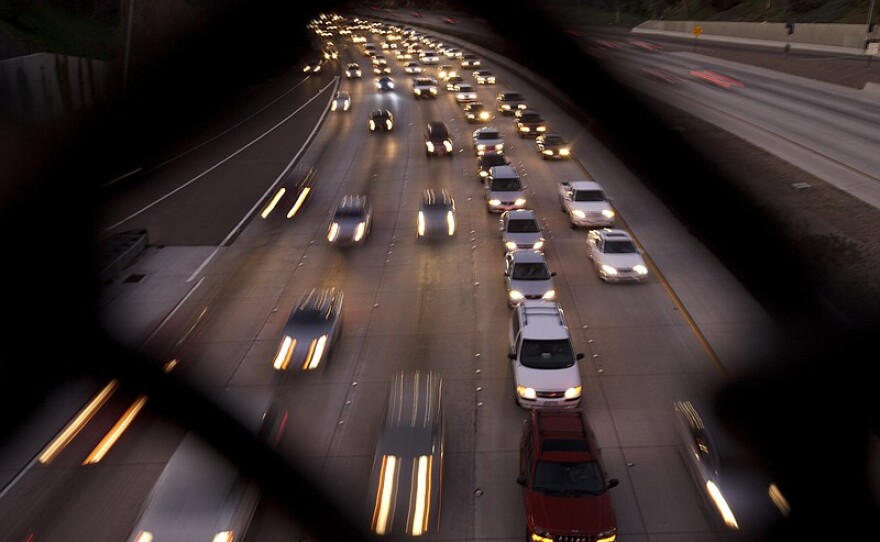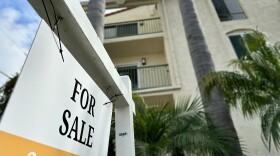our top story on midday edition, remember measure a and last November ballot, it is a countywide measure it is sponsored by the Association of government to raise the sales tax by have sent, it would raise up ultimately $18 billion over 40 years to improve transportation and lower commute times in San Diego. The measure did not pass. But reported by force of San Diego apparently and cover that the -- apparently uncovered that the measure will not have raised that much money not been able to fund all the projects it promised and that staffers will will and -- Sandag Niewood . Andrew welcome. You started reporting on Sandag -- Sandag revenue problem before, if found there was a problem in the way Sandag calculated its revenue rejections, what's wrong with agencies numbers ? there's one very specific component of their long-term economic forecasts that just includes some unsupportable assumptions and that is basically they are income numbers are high in -- and that translates into -- in that translates into them thinking that we're all going to and far more money than we have ever spent in the history of San Diego is a place to -- to track its numbers. The fundamental way we know how much money you are going to is from a sales tax is how much we all spend on items that are subject to that tax and throughout the entire history that they have records for, that number has gone up and down depending on the economic climate during recessions is South foes during boom times -- falls during boom times in boom times it goes up. It has gone in a relatively predictable band, on average about 169. % annual growth. So it increases from year-to-year, in a relatively pretty bold way. Sandag's number. Today would grow by 1.3% on average every year for the next 40 years. Meaning they predicted double the annual increase in growth of how much we would all spend in on just regular taxable items that we ever have in history. When specific staff first discovered this, -- staffers discovered this, one regionalmodel economic model are in the new chief economist I just came in, they panicked and they found the information based on e-mails I am covered they panicked and exchanged e-mails and a lot of them said OMG in the other ones I can think of another powerpowerful an acronym and another -- powerful acronym and another one said WTF . how to direct impact on measure a figures, what did you find out about why the board wasn't notified immediately about the problem ? after the staffers discovered it, they put together presentation that was several dozen slides worth of hard data saying we have a problem here and they presented it to the executive team in December of2015. It wasn't until four months later that's that sandag board approved the measure which included large revenue totaled that was unsupportable so between -- I was unsupportable so between December 2015 and April 2016,sandag was never told and the executive leadership, the number two, did nothing. I talked to them on Friday and did you tell the board? Even if he didn't temporarily your expert Tatian of forecast -- forecasted you alert anyone for the fact that your staffers found this -- staff responders and they said no? The oversight board committed to your last test in Chris they said no. They did not do anything at all with informationwhen she was% it to them by their expert staff. What are the implications of this? Made -- the implications of this goes back to the last tax is, -- in this for -- for multiple forecast, that transmit which was approved in 2004 and that measure now we know have the revenue expectations that were unrealistic so they -- so they are going to say that the reason we have less revenue collected under the -- the -- that we initially spotted was because of the recession, turns out they were the numbers was unsupportable even with the recession -- even with the recession. There is 40s at boys of San Diego and -- voice of San Diego and I have been's aching with the Andrew Keith the -- the reporter at voice of Mac joining me now is director of Sandag, welcome to the program . As reported by voice of San Diego, top officials of sandag first learn the problem with the economic forecast almost a year before the election, why did the agency could see new to use the 18 billion-dollar figure even after learning there was -- even after learning there was an issue #. When staff raised issue in the 2015 it wasn't anything to do with the measure a forecast sales tax revenue forecast, in fact a wasted he was specifically -- specifically with one out output coming from a complex model they were trying to understand about 2015 we had embarked on updating one of our complex models that use of forecast population in women, housing and taxable retail sales that particular component is one of many outputs that come out of that model. Staff have been raised in new stuff came in and trying to figure out why those numbers appeared -- appear to be high in the words there were professional's debate -- professionals debate -- there were professionals debate and disagreement on whether those numbers were in fact wrong and we did not believe in long and believe -- they were long and believe they were of rest of the time. It wasn't until several months later that we put two and two together and we had someone who independently have been calculating sales-tax revenue forecast and did not make a connection between some outputs coming out of highly complex model and in terms of measure a, the discussion -- A, the discussion was separate and in the different time. They prepared a presentation with the modeling -- a modeling chart outlining how in later the projected those tax revenues were in presented that to Sandag officials last spring, he took a similar chart published by voice last up Tober for sandag to make changes why the delay . The delay was not that he wasn't with regard to do -- revenue forecast, I want to make that clear it was in regard to one output that came out of the model of forecasted the number of different things. That output did not directly it was many inputs back then went into developing the sales-tax revenue forecast. There were two difference, different work going on when to update -- want to update the longer-term modelwe're used to forecast and many of the things we do underlies with a long-range planning wedo. It goes out 20, 3040 years into the future and the issue with the measure of a forecast and wasn't raised until a little later and when we spend the time after the election was done to take a look at that will this one we delved into details to see what was driving some of the numbers the errors of -- the errors that we were coming out of the model itself . as reported in voice of San Diego went top officials in sandag and staffers noted that there was this inflated projection for sales-tax revenue, there were e-mails going back and forth, OMG, what's going on, so apparently there was some concern over these specific sales-tax revenue projections. You say is part of a larger model, but apparently they honed in on it right away. That may provide context for those e-mails, it was one of several I think out and we had provided on to the voice of San Diego. For those rather colorful email was between technical staff and one of the newer staff for new chief economist we hired just tired and he was trying to understand the difference between that particular number coming out of the model and why he looked different from the historical information, I was not it was not specific on the sales-tax revenue forecast, it was on the output coming up on a model that staff was attempting to rebuild and modernize that we had in our program to revisit. You think you will have a trouble selling another measure like this to the public when they hear about these faulty projections ? I guessprojection are just -- -- I just -- they have forecast and educated guess. We did not believe in -- no one raised itthat 18 billion-dollar -- the 18 billion-dollar member was a wrong number, we did believe he was ambitious and on -- ambitious number, but -- , but we did not have a reason to believe at the time the number was developed that it was wrong and based upon information that needed to be changed immediately . I have been speaking with chief deputy executive director of sandag, can come what us.
Last November, the San Diego Association of Governments pushed for Measure A.
SANDAG said the countywide half-cent sales tax measure would've raised $18 billion dollars over 40 years to improve transportation and lower commute times in San Diego.
The measure failed to get the 2/3 majority needed to pass.
But reporting by the Voice of San Diego has uncovered that the measure would not have raised that much money, not been able to fund all the projects it promised and that top SANDAG officials knew it.
SANDAG's chief deputy executive director Kim Kawada and Voice of San Diego reporter Andrew Keatts discuss what was known and what the implications are Tuesday on Midday Edition.






